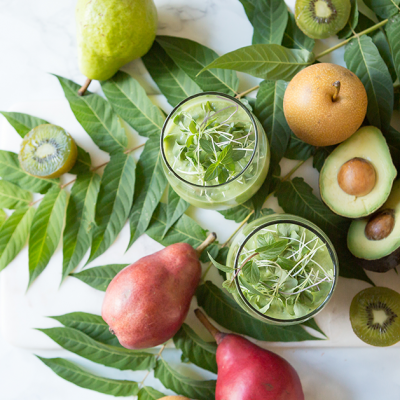Many of us have a memory of biting into a perfectly ripe peach, the juice dripping down our chin and hands. Or eating a slice of refreshing watermelon—a sign that summer is in full swing. It’s true that eating fruit is a pleasurable experience for our senses. It’s also a whole food packed with vitamins and minerals. Compared to sweeteners, it also has a fairly low glycemic response (meaning it doesn’t spike your blood sugar like glucose). Along with an abundant source of soluble fiber, which can act as a prebiotic to feed good bacteria, and help to keep the microbiome healthy. Many fruits also have a high concentration of polyphenols to fight off inflammation, oxidation, and cancer.
Fruit contains sugar in the form of fructose, and for some people, consuming it can be questionable
Glucose can be metabolized anywhere in the body to release energy, while fructose has to be transported to the liver for metabolism. Once in the liver, it can be converted to glucose and stored as glycogen for later use when needed. However, the liver can only store so much glycogen; as a result, any part that cannot be stored as glycogen is stored as fat instead. If fat accumulates in the liver, it’s known as nonalcoholic fatty liver disease and it’s the most common form of chronic liver disease in the U.S. This type of stored fat becomes visible in the mid-section as added belly weight.
High fructose is a particularly toxic form of fructose. It’s commonly found in high fructose corn syrup (HFCS). HFCS is an overly processed form of fructose that is stripped down and devoid of anything other than the fructose molecule. It lacks the prebiotic fiber, vitamins, and minerals that whole fruits provide. For this reason, it wreaks havoc on the liver and it should be avoided.
When to Eat and How Much
One of the five principles of Glow15 is that the timing of your meals is just as important as what they are. That’s why we save carbohydrates for later in the day. You’ll receive the autophagy-promoting effects by eating fat first in the day and saving starchy fruits and vegetables for later in the afternoon and evening. I recommend preparing 20% of your dinner plate with starchy whole vegetables and fruits. My favorite fruits are ones that are lower in sugar but high in polyphenols: green apples, berries, pomegranates, grapefruits, lemons, limes, and olives. That’s right, olives are actually a fruit. In fact, there are many plants we eat that are classified as vegetables but are actually categorized botanically as a fruit — avocados, tomatoes, eggplant, and cucumbers to name a few.
It’s important to practice moderation and make Glow15 your own. Stressing over whether to eat fruit or how much to eat can hinder your body’s ability to clean up inflammation and will take away from the pleasure that can be found in nourishment. Some bodies will be able to handle more fruit than others; it will depend on the state of your metabolic health. Are you overweight or have blood sugar issues? Do you have a gut imbalance like candida, that makes you more sensitive to the sugars in fruit? If so, it’s best to avoid tropical fruits like bananas, mango, and pineapple. A typical serving of fruit is one medium apple, one half-cup of berries, or one half-cup of mixed fruit. If you’re extra active during the day, it’s okay to eat a little more fruit. Always stick to whole foods; it’s best to limit or avoid dried fruits and fruit juices because the sugars are too concentrated and can easily create an imbalance.
To Finding Your Sweet Spot,





